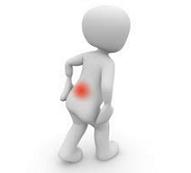The concept of sciatica or sciatica , which derives from the late Latin sciatĭcus , can be used in different ways. As an adjective , it refers to what is linked to the hip (the protruding parts that are formed by the bones that are above the pelvis). The notion can also refer to the sciatic nerve : the thickest and longest in the body, distributed in muscles of the foot, thigh and leg.
 Beyond these definitions, the most common use of the idea of sciatica refers to neuralgia of this nerve . Sciatica, therefore, causes pain in the hip area.
Beyond these definitions, the most common use of the idea of sciatica refers to neuralgia of this nerve . Sciatica, therefore, causes pain in the hip area.
Sciatic pain can be caused by irritation or compression of this nerve or the lumbar and sacral nerves. The ailment can be experienced in areas of the feet and legs, in the buttocks or in the entire lumbar region. Along with the pain , a sensation of numbness and tingling may appear.
Specifically, the most common symptoms of sciatica are the following:
-Pain in the lower back area.
-Pain that is relieved when the patient lies down or lies down.
-Constant pain in only one of the legs.
-Tingling and weak sensation in one leg.
-Pain in the foot or toes.
-Stringing pain that arises, especially when walking.
Due to sciatica, a person may have trouble controlling or moving the leg. That is why it is an illness that causes great discomfort and may require you to remain at rest until it is reversed.
It is important to keep in mind that sciatica can occur for various reasons. That is why the cause must be determined to follow the corresponding treatment .
Spinal stenosis and spinal disc herniation , for example, can cause sciatica. Pregnant women can also suffer from this neuralgia due to the spinal compression caused by the weight of the fetus and the pressure that the uterus places on the sciatic nerve.
To minimize the pain caused by sciatica, you can use analgesic and anti-inflammatory medications, stretching exercises, and massages .
In the same way, it must be taken into account that other fundamental aspects of the treatment of sciatica are the following:
-Repose.
-Application of heat or cold, which can significantly help reduce existing pain.
-Epidural injections of corticosteroids that are very useful to reduce inflammation and also to relieve pain.
-In some cases, treatment based on the keys already mentioned or drugs does not provide relief of any kind. In that situation, we will have to resort to surgery. Specifically, this can be of two types: lumbar laminectomy or open decompression and microdiscectomy, which is a minor class surgery. The latter is carried out when the cause of sciatica is a herniated disc, which is pinching the disc nerve. On the other hand, the first surgery will consist of removing the part of the bone or disc that is responsible for the aforementioned impingement and usually has an effectiveness of between 70% and 80%.
